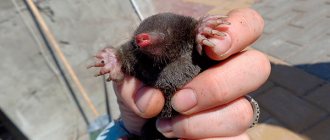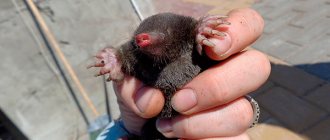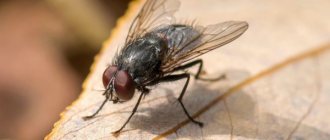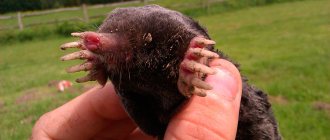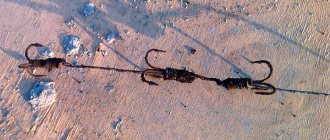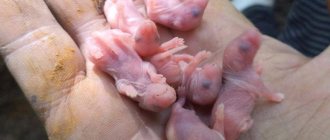What a mole looks like: a brief description and photo of the animal
To quickly identify a mole, it is important to be able to distinguish it from other animals that dig minks. It is often classified as a rodent, but this opinion is erroneous, because the mole’s jaw, compared to mice and rats, is not sufficiently developed.
The common mole, also known as the European mole, is a small animal with miniature eyes and a round, elongated body covered with thick fluffy hair. The mole's straight-growing fur changes direction of growth as the animal moves through its burrows. Due to constant friction with the ground surface, the fur begins to thin and fall out. It is because of this feature that the animal sheds three times a year - once in each season, except for the winter period, when the fur helps retain the necessary heat.
A mole's fur always has a uniform color - black, dark gray or dark brown.
The mole is characterized by a small body weight - no more than 120 grams. The average length of the body is 17 cm, and the small tail is about 3 cm. Traditionally, males are somewhat larger than females.
Due to its lifestyle, the mole has a characteristic body structure. The shovel-shaped front legs, which are quite large and wide with palms facing forward, make it easier for him to move underground. Large and strong claws allow the animal to break through underground labyrinths.
The mole's small muzzle ends in an elongated spout that looks like a proboscis. The head practically merges with the body, without pronounced outlines of the neck. The eyes of this burrowing animal are miniature in size and have a special structure - they lack a lens and a retina. It is for this reason that the mole sees practically nothing. In contrast to this feature, he has well-developed senses such as smell and touch. They give him the opportunity to evade threats from predators, as well as perfectly navigate the underground space.
Harm of moles to humans, plants, trees and earthworms
The active life of moles on land, gardens and summer cottages is fraught with numerous problems.
The main harm of these animals to humans is the spread of infection, which can be deadly if the immune system is reduced. It is known as tularemia or piroplasmosis.
In addition, the mole is a source of a number of parasites - in particular, worms, fleas and ticks.
Moles also pose a certain degree of danger to domestic animals - for example, horses and cattle. They risk breaking their legs if they fall into a hole dug by an animal.
Burrowing animals cause a lot of damage to trees and plants that grow in areas
The fact is that while digging its passages, the mole throws out part of the earth, as well as any root crops, bulbs and roots that come across its path. If the animal does not have enough strength to pull out larger tubers, it causes serious damage to them, leading to the death of the crop.
Earthworms live in the soil, loosening and processing it. They make up a significant part of the moles' diet.
Burrowing animals also cause great harm to lawns and lawns, destroying their integrity and attractiveness. Moreover, lumps of earth thrown out quickly damage the lawn mower mechanism.
Blind animals are most active in early spring. After the soil dries completely, the damage begins to smooth out.
Benefits of moles: destruction of insect pests, aeration and loosening of the soil
The presence of moles in a garden or summer cottage is useful to some extent. Therefore, several important properties should be taken into account.
Moles eat many other enemies of fertile soil and vegetation, including small rodents trapped in burrows, as well as harmful insects and their larvae. Weed seeds are also part of their regular diet.
Why does a mole build a hole?
Let's immediately determine that there are many animals with this name. We're talking about everyone for now. They, of course, have their own characteristics. Only in this part of the article will we talk about a certain “middle mole”. Let's consider the functions of his home. There he spends almost his entire life. Note that the depth of a mole's hole is determined by the tasks for which it is dug.
In general, it consists of several floors. The first lies ten to twenty-five centimeters from the soil surface. This floor consists of a system of passages. The animal needs them to look for food. After all, it is precisely “hiding” in this layer of soil. The mole descends below for other purposes. He creates the second (in depth) floor in order to breed offspring and preserve his reserves.
Mechanical methods
Traps
Special traps are one of the simplest and most accessible mechanical methods of controlling moles. At the request of the site owner, you can purchase a ready-made version, or make a simple device yourself.
The mole trap in the shape of a pipe is characterized by the greatest humaneness.
The most humane feature is the pipe-shaped mole trap, which is widely used in almost all gardens, flower beds and vegetable gardens. It is a hollow structure with movable doors on each side, which operates automatically. With its help you can catch an animal without injuring it at all. This allows captured animals to be taken outside the site and released into the wild.
The principle of operation of the device is very simple: once a mole gets into the pipe, it cannot open the door from the inside.
In stores and departments dedicated to gardening, you can often find scissor traps made of reliable, durable steel. They are inserted directly into mole holes, and then covered on top with a bucket, jar or cut plastic bottle. As soon as the animal falls into such a trap, a powerful mechanism is triggered, preventing it from freeing itself.
The plunger trap is the most powerful and effective. Accessing it requires a minimum of practice and skill. It is an excellent alternative to traditional traps, as it is activated when the mole pushes the earth to restore the tunnel.
Traps
The tunnel trap is a structure based on a half-tunnel. Its working parts do not jam from pebbles, peat and other foreign objects, so such a trap can be easily hidden in the ground. It works effectively under any conditions. The capture of a pest animal is indicated by the raising of the spring above the surface of the ground.
The tunnel trap is a structure based on a semi-tunnel
A wire trap is the most affordable and simple device. It is made in the form of an elongated spring, equipped with a guard, a loop, and also a special foot for pressing down a mole caught in a trap.
Similar devices are installed in mole tunnels, which the animal uses for feeding. In this case, it is necessary that the loops of the trap are in close contact with the walls of the feed passage. The guard in this design prevents the movement of the animal. As soon as the mole pushes this part, the spring opens and with a special paw presses it against the loop itself.
Reproduction
In Belarus, the mating period for moles begins shortly after the snow melts. In the western and southern regions, pregnant females begin to be seen from April 17, and in the northern regions - from May 5-8. Early and cold spring delays this period, which entails a prolongation of the mating period, birth dates, feeding of the young and their settlement. This leads to the prey of a large number of pregnant and lactating females, and consequently to an overall reduction in the mole population.
The duration of pregnancy in females is 35–40 days. The largest number of pregnant females occurs in May. Most females give birth to 6 cubs. On average, there are about 5 cubs per female.
Females usually have one litter per year. However, on the territory of Belarus, especially in the western and southern regions, it was found that 20–25% of females bear litters twice. The second, summer, offspring occurs from the end of June to the end of July. Signs of a female that has given birth to a second offspring are well-developed mammary glands, nipples (4 pairs of them), around which the hair is wiped. In summer, female fertility is lower than in spring: there are about 4 cubs per female.
Feeding the young continues for about a month. At this time, females often fall into traps. Young moles live peacefully among themselves, but as they mature they become pugnacious. At the age of two months, in the middle or end of June, young moles, the size of which does not exceed 3/4 of an adult animal, begin to be caught in traps. They already lead an independent lifestyle. From the end of June - beginning of July, their mass resettlement begins, which ends by the end of August.
In the first days of settlement, young moles run along the tunnels several at a time. Often young moles can be found on the surface of the earth, where they crawl out through holes in passages or molehills. Sometimes it is possible to catch with one mole trap during the summer, in a course in which all the moles go in one direction, up to 50 or more specimens, of which young animals account for up to 75%.
Moles spread very quickly, as they run along ready-made passages at a fairly high speed—up to 6 m per minute. Research by scientists shows that young moles cover a distance of up to 700 m in 20.5 hours, and adults cover 50 m in 20 minutes. Young moles are more prone to movement than adult moles; the latter do not go further than 400 m in 11 months.
We suggest you read: Mealybug - how to fight it on indoor plants
Material prepared by: horticulture specialist Buinovsky O.I.
The moles' rut begins with the period of snow thawing. The mating period for moles begins in early spring (March-April). Before the onset of mating season, males expand their burrows in search of females. Their genitals are significantly enlarged.
Pregnancy in a female lasts about 40 days. The cubs are born helpless, naked and blind, weighing only 2-3g. As a rule, females give birth once a year, 4-6 cubs are born. The mother constantly guards the offspring, with the exception of the time when she is getting food. At the age of 1 month, the offspring reaches the size of an adult mole. As the cubs grow older, they become pugnacious and do not get along well with their fellows.
After reaching the age of 1-1.5 months, the young leave the nest and begin searching for their own site. During this period, young animals are most vulnerable to predators.
A mole lives on average 3-5 years.
Acoustic methods
Purchased ultrasonic repellers
Ultrasonic mole repellers are widely available, which are both highly effective and humane.
Ultrasonic mole repellers are widely available
The operating principle of these structures is based on the supply of a special signal, which is amplified under the influence of a motor. Modern electronic ultrasonic repellers are capable of operating within a radius of 40–45 meters. However, for maximum efficiency, there should be no voids or large-scale obstacles on the territory. To ensure the highest sound quality, it is necessary to place the device as close to the ground as possible.
Vibration devices
Vibrating devices for repelling moles operate primarily on solar energy batteries. Their design is an elongated aluminum rod topped with a peculiar cap. Immediately after being fixed in the ground, the device begins to generate high-frequency waves, which have a very painful effect on the mole’s auditory organs. The animal takes the vibration created as a danger signal, and is therefore forced to leave the area.
Star-nosed
Star-nosed mole
The second name for the mole is star-nosed. It differs from its relatives by its unusual nose. The stigma consists of 22 soft processes - tentacles. Thanks to them, the animal gropes for food. The rest of the body structure is similar to the European mole.
- The mole's body is elongated, about 22 cm long.
- The tail is long - 8 cm.
- The coat is thick, soft, silky, black and brown in color.
- There are no auricles.
- Small eyes are not covered by skin.
The starfish swims and dives well. The mole feeds on crustaceans, slugs, earthworms, larvae, and mollusks. In addition to the underground, aquatic lifestyle, it leads a terrestrial one. It can build nests in rotten stumps, hollows of old trees, under leaves. Prefers swampy areas, soil with high humidity. Often found near rivers, lakes, and swamps in the United States.
Chemical methods
Poisonous baits
It is preferable to combat mole pests without the use of toxic substances, so as not to cause irreparable harm to surrounding people and plants. However, if all other methods have proven ineffective, it is advisable to use poisonous baits as a last resort. One option is an earthworm, cut into pieces and generously sprinkled with ordinary rat poison. You can prepare several of these baits and place them in each mole hole.
Also effective in this case:
- aluminum phosphide;
- carbide compounds;
- granulated bromadialone;
- Brodifacoum.
Siberian or Altai mole
A variety of common mole. It differs from its relatives in its large size. Lives in Siberia and Mongolia.
- The mole's body size is about 20 cm. Females are slightly smaller.
- The length of the tail does not exceed 4 cm.
- The eyes are round, small, and have a movable eyelid.
- The muzzle is elongated, with a well-defined nose.
- The ears are small, almost invisible.
- The mole's shovel-shaped front paws have long claws; the hind paws are similar to rat limbs.
- The coat is dark black, but can be smoky, yellow, or brown.
- The Siberian mole weighs from 100 to 225 g.
A distinctive feature of this type of mole is its long pregnancy. Fertilization occurs in the summer, but the embryo freezes until spring. Cubs appear in April-May. Pregnancy lasts 9 months. There are about 11 cubs in the litter.
The main food is earthworms, followed by beetle larvae, pupae, and small insects. A Siberian mole can easily gnaw on a mouse, lizard, sick rat, mole cricket, snake, snake, or frog. There are cases of cannibalism. The winner takes possession of the victim's possessions, marking his territory with a special secret.
Physical destruction measures
Flooding holes with water
Flooding a mole hole with water is a very popular and simple method of pest control. In this case, you need to insert the hose directly into the hole and fill it to the very edges. However, the effectiveness of this method is highly questionable, since the animal will quickly leave the flooded home and start digging a new one. As a result, such burrows can form throughout the entire territory of a summer cottage.
With a shovel
This old folk method of mole hunting is as follows:
- in small steps you should move along the groove of the mole tunnel, while pressing down the soil with grass and leveling the ground;
- with a shovel and hammer, position yourself as close as possible to the location of the animal - it can be easily identified by its fresh furrows;
- if you notice an extension of previously made furrows or the appearance of new ones, you should quietly get up and with a sharp movement stick a shovel behind the area where the mole can presumably operate - this action will block its path;
- the second shovel must be stuck in the same way at the end of the mole's passage - if the animal does not fall under the shovel, destroy it by hitting it with a hammer.
Construction method
Externally, a mole hole looks like small loosened tubercles of soil. The animal digs the ground with its front paws, which are shaped like a shovel and equipped with long, sharp claws. With the help of such equipment, the densest soil can be easily loosened.
The absence of large ears and a sharp muzzle make it easy to move underground, calmly get worms, and catch insects. With its hind legs, the animal throws the soil back and then transports it out. The places where the deep hole is located are marked from the outside by embankments.
In numerous labyrinths, other inhabitants of the underground world can settle; very often they become mice and earth rats. However, the mole does not give up without a fight and calmly drives the invaders out of his possessions.
mole hole
Folk remedies
Homemade windmills made from reeds, champagne bottles, plastic bottles and cans
To effectively repel moles, you can build your own windmills from scrap items.
For a long time, reed stems have been used for these purposes, which are hollow inside, and therefore create a characteristic scaring sound in the wind. One reed should be inserted into each mole hole. This will create the effect of a wind tunnel, which will begin to create sounds of certain frequencies even with minor gusts of wind.
To effectively repel moles, you can build your own windmills from scrap items.
Using empty plastic bottles with a capacity of 1.5 to 2 liters, or glass champagne bottles, you can easily create a structure that repels moles. In addition to the bottle, this will require a metal tube that fits the diameter of the bottle neck. One end of the tube must be firmly buried in the wormhole, and a bottle must be placed on the other. The deterrent effect is achieved through the noise generated by air entering the bottle and metal tube.
Using empty plastic bottles, you can easily create a structure that repels moles
An ordinary beer or Coca-Cola can can also be useful for creating a simple mole repeller. All that is necessary is to put it on a metal tube previously dug into the wormhole. A more pronounced effect can be achieved by cutting characteristic blades into the body of the can. Thus, with every gust of wind it will spin faster and rumble louder.
Smell repellent: kerosene, ammonia, rotten fish
Unpleasant, pungent and irritating odors are no less effective in combating pest animals than loud sounds. To do this, you can place a piece of rotten fish inside the animal’s hole, or spray the entrance to the home with ammonia or kerosene. Since the mole’s sense of smell is very developed, this method will force the animal to leave its house.
Nutritional Features
Field rats prefer grain, cereals, flour, seeds, root vegetables, and juicy grass. It also feeds on small insects, fish, frogs, and mollusks. The land rat swims well, dives well, and is capable of foraging underwater.
The lack of food in the wild forces the animals to move to fields with grain crops. Rats dig holes in the ground, disrupting plant growth. With a large number of rodents in the field, it is impossible to harvest the crop using machinery. The spikelets fall, crumble, and get tangled.
The damage caused by the earth rat is irreparable for gardeners, gardeners, and farmers. A large colony of animals can destroy the entire crop. Animals are forced to sharpen their front teeth on hard surfaces to prevent their growth. They often gnaw tree bark. An attack by a large number of pasyuki is dangerous for poultry and animals.
Is it possible to get rid of moles with the help of cats and dogs?
When using domestic dogs and cats as mole hunters, certain nuances must be taken into account:
- Only an adult and mature animal can pose a serious threat to moles;
- First, you should carefully observe the mole tunnels, and as soon as the animal begins to move along them, bring a dog or cat to this place. This will probably awaken the hunting instinct in the animal;
- When using animals to catch moles, do not treat holes with toxic substances.
What does a mole eat?
It is clear that with such a specific lifestyle, the animal must have a special diet. And they eat everything they meet along the way. These are mainly plant parts. Roots, tubers, acorns - all this ends up in their stomachs (and not only). Researchers of this interesting animal say that its reserves can be impressive.
For example, the mole rat makes several storerooms in which up to twenty kilograms of food can be found. Agree, one can envy the animal’s hard work. In addition, this factor explains to what depth the mole digs. Stocks are being made for the winter. Therefore, they should not “disappear”, in particular from the cold. This means that in those areas where there is more frost, the animal hides deeper and vice versa.
Reviews from summer residents
We set some homemade traps, but they were of very little use. It’s a feeling that the mole senses these traps and avoids them, or something like that, since not a single one was caught that way. It’s hard for me to explain the design of the trap; my husband made them, he knows.
Regina
https://farmerforum.ru/viewtopic.php?t=617
A very good way to get rid of moles is to get a cat. When the neighbor cats started visiting me, in the first summer they caught a lot of moles, and the rest left and went to the neighbors. Now moles appear, but in minimal numbers; in the summer they are caught by cats and cats, and we live quietly all summer. And since they are on the site and doing their business, then, apparently, there remains a smell that scares away the moles. By the way, the number of moles among our neighbors has also decreased. But we must admit that cats themselves are also pests when there are a lot of them and they are neighbors.
Julia
https://farmerforum.ru/viewtopic.php?t=617
Yes, now it seems that it is no longer a problem to fight moles - such a spinner is sold in stores, it chirps loudly. From this sound the moles not only leave, but run away. And they are sold in all flower shops - where there is fertilizer, flower pots, etc. She sticks herself into the hole as deep as possible. And there it starts to chirp. The moles will leave. There are such things both more expensive and cheaper. Of course, more expensive is better. My friend took everyone out. Although he has both dogs and cats on the property.
Natalia N.
https://farmerforum.ru/viewtopic.php?t=617
No drugs helped us, they called specialists who installed some kind of contraption, maybe a repeller, or something else... After that, it was still pah-pah...
IrinaIrina
https://forum.osadovod.ru/threads/borba-s-krotami.15/page-2
And as soon as I arrive at the dacha in the spring, I place these metal poles with beer cans all over the site. They rumble from the wind and the vibration is transmitted to the ground. Only if the wind is too strong, light cans may fall from the tubes. Actually, this is what happens in winter - you arrive, and they are all lying on the ground. But in March I hung it again and no more new piles of earth seemed to appear.
Igor V.
https://forum.osadovod.ru/threads/borba-s-krotami.15/page-2
I throw a 1.5-2 cm sulfur bomb into the hole, set it on fire and blow air into it with a small fan. Acrid smoke goes along all the passages and comes out of very unexpected places, dispersing all living things far and for a long time. It’s not my fault who didn’t hide.
uncle Vova
https://www.forumhouse.ru/articles/garden/6683
Protecting the site in winter
Since moles do not hibernate, it is necessary to take care of protecting the area in winter. Don't forget about prevention. Do not leave heaps of manure on the site; they attract worms and all kinds of larvae, and moles appear behind them.
Having introduced the reader to various methods of how to get rid of moles at home, we believe that the method he chooses will be humane in relation to the animal, because it is not without reason that in some countries it is listed in the Red Book.
Did you like the article? Subscribe to the channel to stay up to date with the most interesting materials
Source
Video: a new way to fight burrowing animals
https://youtube.com/watch?v=IpanOtpYIxI
There are many ways to combat moles that cause serious damage to gardens and summer cottages. They all differ in complexity, effectiveness and safety for surrounding people and animals. Having learned about the features and nuances of each and based on the individual situation, choose the best option that will allow you to say goodbye to pests, and also guarantee impeccable beauty and comfort on the site.
- Author: Veronica Mirage
Rate this article:
- 5
- 4
- 3
- 2
- 1
(2 votes, average: 4.5 out of 5)
Share with your friends!
Rat
Rats are very smart. And also, like any rodent, they are dangerous because they are carriers of many diseases. In the countryside, you can most often find a gray rat. People call it pasyuk.
It is quite large, can reach 27 cm in size. Pasyuk is omnivorous and swims well. It is he who digs holes in vegetable gardens, not particularly deep, but branched.
The rat is prolific - per year it can give birth to 3 litters of up to 10 cubs each. This large pest will also fight a large enemy if there is no place left to run to. Pasyuk can even attack a person.
Due to the mole cricket's addiction to cabbage, it is also called cabbage.
The cabbage nests are shallow - only 10–15 cm from the surface. In them, the female takes care of her offspring. The nest has many branches and exits.
The female regulates the conditions inside for the best development of the larvae - she opens and closes the entrances, gnaws out the roots of plants so that the nest warms up better. So the root system of plants is sufficiently affected, which leads to their death.
The mole cricket can overwinter in the ground at a depth of up to 2 m, and can also overwinter in manure. Often it is with compost that it ends up in gardens.
Fighting mole crickets, like other pests, is not easy. Getting rid of cabbage weed needs to be approached comprehensively, focusing on its characteristics and habits. Let's look at some preventive and preventive measures.
The first method is loosening and digging. You should try to dig no less than 15 cm deep. This procedure needs to be done about 3 times throughout the entire season. This way you will find mole cricket nests and eggs in the soil.
The soil with eggs must be removed from the garden - poured into a bucket or other container. And if you come across an adult mole cricket, then it also needs to be destroyed - crushed or chopped.
The second way is to lure with manure. In the spring, you can spread heaps of compost around the garden - mole crickets will find this a good place for their nests. Check the piles periodically, and if you find eggs or an adult, destroy them.
